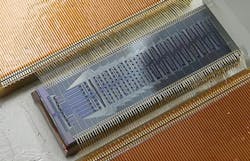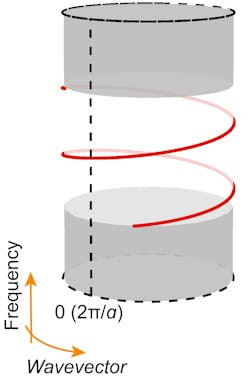Baile Zhang developed a chip that slows light for efficient quantum information processing. And Leong Chuan Kwek’s chip leverages the quantum properties of light and uses photons to deduce the chemical properties of molecules, which opens the door to faster drug discovery.
Laser Focus World: What inspired your work?
Zhang: Our initial interest lay in electromagnetic materials known as photonic topological insulators, which are photonic crystals that control photons analogous to how topological insulators control electrons. Although a few proposals have discussed using photonic topological insulators to slow down light, they tend to be overly complex and difficult to achieve. In 2021, we came up with the idea of coupling topological photonic states with energy bands known as flat bands—a hot topic currently under active investigation. This idea made the concept of topological slow light practically achievable.
Kwek: Our group is interested in using light for quantum simulation, with the idea of controlling the interactions of photons to simulate a physical system or process that would be difficult to model using classical computing. The vibronic transitions of molecules are a good target for this approach. Our team is proficient at translating linear optics platforms to photonic chips, so it made sense for us to experiment with an integrated chip.
LFW: Can you describe the basic optics/photonics/quantum concepts involved?
Zhang: The first concept is the photonic chiral edge states, which are electromagnetic waves (electromagnetic modes) that propagate along the edge of a photonic topological insulator. These modes are unique because they only travel in one direction, either left or right, which is why they are called “chiral.” While these chiral edge states are guaranteed, their speed of propagation can be engineered.
The second concept involves flat bands, energy bands independent of momentum, corresponding to zero group velocity. This means photons at the energy level remain fully localized at specific positions.
By coupling chiral edge states with flat bands, photons can travel in a single direction with no reflection and retain chirality but at much slower speeds due to the “dragging” effect of the flat bands.
A more abstract description is that these chiral edge states wind around the Brillouin zone— points in the imaginary space of the crystal lattice—multiple times. This is how our scientists conceptualized this phenomenon.
Kwek: Our experiment uses Gaussian boson sampling, a technique that showcases quantum advantage, with quantum computers claiming to surpass supercomputers significantly. This method parallels the transition probability of molecules between vibronic states and demonstrates that the Franck-Condon Factor, which measures the transition probability, and the concept of “permanence” within matrices are mathematically related. Permanence is the idea that algebraic operations should behave consistently within every number system.
The complexity of boson sampling is computationally challenging, and we use this technique in our experiment to calculate the probabilities of vibronic transitions in molecules.
LFW: Any interesting design work involved?
Zhang: Our design is simple yet elegant. To slow down light, we attached devices called resonators to the edge of the photonic topological insulator to generate the required flat bands—which slows down the chiral edge states within the photonic topological insulator.
Kwek: To increase the sensitivity of detection, we made use of “squeezed” coherent light with low quantum noise. Light in a coherent state is equivalent to a displaced vacuum state. In the original scheme, researchers use light that is displaced and then squeezed to remove noise. But we found that the analysis worked with light that is first squeezed then displaced.
LFW: Main thing you’d like people to know about your work? Key benefits?
Zhang: The key benefit of our research is achieving broadband slow light without backscattering. Slow light is typically constrained by narrow bandwidth, and the slower the light the more it suffers from backscattering. Our demonstration proves it’s possible to enable slow, unidirectional light propagation across a much broader bandwidth than previously possible.
Kwek: The main message is the possibility of harnessing quantum theory as a new technique for chemistry and possibly molecular biology. The technique can be extended to many more chemistry problems amenable to graph theoretic analysis—the analysis of interconnected networks to solve complex problems. The key benefit will be the insights gained in chemistry and molecular biology through our investigations.
LFW: Most surprising/coolest aspects of your work?
Zhang: The coolest aspect of our work is that we addressed a long-standing challenge in slow-light engineering using an exceptionally simple design. The “a-ha” moment came with the realization: “A-ha, it’s just this simple!”
Kwek: We also show in the paper that we can probe the molecular spectrum with and without excitations. We simulated the vibronic spectra of formic acid (CH2O2) for four vibronic modes and thymine (C5H6N2O2) for seven modes using a 16-mode integrated photonic chip. We simulated spectra for naphthalene (C10H8), phenanthrene (C14H10), and benzene (C6H6) for more diverse transitions. We hope such techniques will provide insights into bigger and more complicated molecules.
LFW: Any big challenges to overcome?
Zhang: There are several challenges ahead. Since the photonic topological insulator requires a magnetic response, scaling the approach to optical frequencies for other applications is difficult. And extending the working bandwidth of the system is another area that demands further investigation.
Kwek: Making the chip larger, which is necessary to simulate bigger molecules, involves more heating to adjust the phase shifters and it becomes more difficult manually. It’s really an engineering problem, but I think it should be possible.
LFW: What’s next?
Zhang: Our findings have the potential to be applied to quantum computers operating at microwave frequencies. The next step will be integrating these designs with qubits—basic units of information used to encode data in quantum computing—for quantum information processing.
Kwek: We’re exploring more applications of the chip to solve chemistry, molecular biology, pharmaceutical, and logistics problems.
FURTHER READING
F. Chen et al., Phys. Rev. Lett., 132, 156602 (Apr. 11, 2024); https://doi.org/10.1103/physrevlett.132.156602.
H. H. Zhu et al., Nat. Commun., 15, 6057 (2024); https://doi.org/10.1038/s41467-024-50060-2.
About the Author
Daphne Ng
Dr. Daphne Ng is the science communication lead at Nanyang Technological University, Singapore’s Corporate Communications Office.


